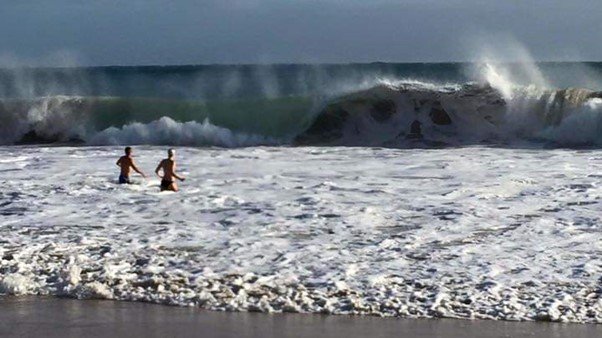
The latest in beach safety research
This blog is a space to share the latest on beach safety research. We provide information and updates on our own projects, and also love to share what others in the community are up to. If you would like to submit a blog, please get in touch
Find a blog:
Deep dive shows increased student belonging
Our new report took a deep dive into the experiences of international students who enrolled in the water safety programs. Beyond the physical and mental health benefits, students reported an enhanced sense of belonging both to the university and to the broader community, and saying the experience was a highlight of their time in Australia.
It’s not the beach: it’s us
Our research looked at risk factors for surf rescue and found a very clear trend: every swimmer outside of the flagged patrol area is almost ten times more likely to need rescuing than the swimmers between the flags. Let that sink in. Doesn’t matter who you are. Doesn’t matter how crowded it is between the flags. Ten times more likely to need rescuing.
What’s the risk?
How do beachgoers evaluate risk? To answer that question, we used a unique multidisciplinary database combining beachgoer surveys, marine and weather data and lifeguard hazard assessments to examine beachgoer’s risk perception at La Lette Blanche, a beach in southwest France.
Selfie injuries to viral stunts: social media risks
Our research into risk-taking behaviour associated with social media use shows the harmful repercussions of social media use do not only happen online, or just affect mental health. There are many real physical risks that stem from social media use, particularly for children and young people.
Unanticipated Drowning Spikes
From late February into March drowning deaths stayed high right across the country with a spate of coastal drowning deaths in Tasmania, Victoria, NSW, Queensland, South Australia, and Western Australia.
Surfers: Lifesavers of la mer
Researchers have analysed data about surfers performing bystander rescues in France and found more than half those surveyed have rescued people in distress, saving hundreds of lives.
Surfers savvy on public health priorities
Cleaning up the ocean and working to prevent drowning have topped a list of surfers’ funding priorities, reflecting the health issues which are most likely to affect them in the waves.
Signs of Confusion
What if beach safety signs designed to save lives are instead putting lives at risk with messages that are unclear to the people they are supposed to help protect?
Mandatory Lifejackets for Rock Fishing
When NSW introduced mandatory lifejacket legislation for rock fishing, what affect did it have on unintentional drowning deaths?
Cervical Spine Injuries and the Beach
I see people catching the waves and putting both arms down their side and going ‘over the falls‘ head-first. It absolutely terrifies me every time I see it.
Risk Communication: Preventative Lifeguarding
Ocean lifeguards are highly proficient at rescuing people from dangerous conditions and providing high quality on-scene care, but preventing people from needing rescue is a skill that requires practice and experience.
Public Rescue Tube Deployment in Hawai’i
A recent study of the public rescue tube deployment in Hawai'i determined that these devices in fact did have a “protective effect” on Kauai’s drownings during the years studied. Researchers noted that there was a lower rate of any type of drowning on Kauai during the period after the tubes were deployed.
Instagram Grant: Water Safety at Selfie Hot Spots
The selfie is a modern phenomena which can have tragic consequences. Temporary lack of self-awareness and concentration can lead to slips and falls; chasing the perfect selfie can lead people to visit risky locations at hazardous times.
The Global Surfer Survey Launch
The Global Surfer Survey, developed by the UNSW BSRG with the support of Surfing NSW, aims to improve understanding about surfers on a range of topics. This online survey aims to collect the opinions of surfers on a range of physical, social and environmental issues.
Dye in the Rip
Various types of coloured dye have been used in rip currents for many years as an educational tool to help people better understand the speed and trajectory of this common beach hazard. It’s encouraging to see a new study by Indonesian researchers who released dye into a rip current at Drini Beach.
Coastal Drowning Trends: Costa Rican Nationals vs Visitors
Costa Rica has some of the world's best beaches and is a top-rated global tourist destination. Unfortunately, Costa Rican beaches are also dangerous and drowning among tourists has been a particular problem.
Effects of COVID-19 and Bushfires on Coastal Drowning
The COVID-19 pandemic altered beach behaviour and coastal use. In Australia, the COVID-19 outbreak immediately followed the worst bushfire season on record: the ‘black summer’ fires burned 18.6 million hectares (46 million acres), killed at least 34 people, significantly reduced air quality, and forced thousands to evacuate (many via water).
Snorkelling-Related Drowning Literature
Despite being a significant cause of death in coastal waters, data on who is at risk and the best way to prevent snorkeller death and injury is scarce. International researchers connected through IDRA to conduct a systematic review on the topic.
Coastal Drowning Risk in SA: Tourists and Recent Arrivals
Researchers from the University of Adelaide and the UNSW Beach Safety Research Group published a study exploring fatal drowning risk among tourists and recently arrived individuals from overseas at beaches in metropolitan South Australia.
2021 Beach Safety Technology Conference
More than two hundred beach safety professionals and researchers from all over the world participated in the 2021 Beach Safety Technology Conference, "an international forum exploring the use and development of technology for ocean lifeguards, beach safety professionals and researchers." The free conference was hosted for free by the University of New South Wales (UNSW) Beach Safety Research Group and Smart Beaches.




















